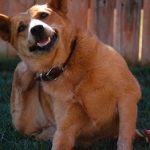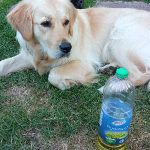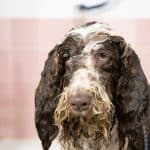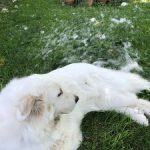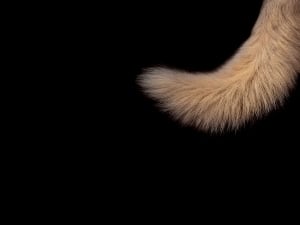
In many situations, your dog’s tail may become matted, tangled, or coated in brambles or other irritants.
It can be daunting trying to decide how best to resolve these issues, and many of you may wonder if it’s time to shave your dog’s tail instead of trying other methods.
Today, we’ll cover when you should shave your dog’s tail and when you shouldn’t.
We’ll also explain various issues that your dog may experience with their tail, including matting, entanglement, and irritation, and how to handle these problems.
Outlined below is a list of best practices to properly care for your dog’s tail, so read on to learn how you can handle any issues your dog might run into in this regard.
How to Keep Your Dog’s Tail Tidy
Depending on its breed, a dog’s tail can quickly become tangled, dirty, or even matted if not properly cared for.
This is usually only a problem for dogs with long, lush tails, like bichon frises or golden retrievers.
While most of the matting in a dog’s tail is easily preventable, matts can occur even with preventative practices in place.
When this happens, the matts must be removed.
First, you’re going to need a good conditioner, as conditioner is a must when getting rid of matts.
You can also add a spray detangler to help moisten the dog’s hair and loosen the matt.
Cornstarch powder has also been known to help loosen tangled or matted fur, so you can try sprinkling some onto your dog’s tail also.
Peanut butter, containing natural oils, will help with de-matting also if you’d rather use that.
Whichever detangler you choose to go with, ensure you work it into their fur and let it sit for a few minutes to achieve the best results.
Next, you’ll want to brush out the matted or tangled fur.
Start by separating the matts with your fingers one by one, working from the end of the tail towards the rump and gently pulling them apart as you go.
After you finish this step, hold the dog’s tail up and using a pin brush, brush the fur straight down and away from the direction of hair growth.
This not only will help to detangle any matts, but it will also remove any debris caught in your dog’s fur.
Make sure to be careful of your dog’s sensitive anal area while completing this step.
After you’ve finished brushing the hair, use a metal-tooth comb to comb through it to handle any remaining matts.
To do this, you’ll want to hold the hair up and away from the tail and gently work the comb through it.
The best way to make sure you don’t cause your dog any pain or discomfort is to make short strokes with the comb.
How to keep your dog’s tail in good condition
After successfully untangling your dog’s tail and removing any debris and matts from its fur, you should follow strict prevention practices to ensure this issue doesn’t come up again.
Make sure to give your dog a weekly bath, using a detangler or conditioner on your dog’s tail to keep the fur loose and untangled.
You can also hold the dog’s tail up and brush in circular motions to stimulate natural oil production and remove any debris that may have gotten caught underneath.
However, some dogs may experience severe matting in the fur on their tails, requiring more drastic measures.
Tips for Shaving or Trimming Your Dog’s Tail
If the matts in the fur on your dog’s tail are severe enough, you may have to trim or shave your dog’s tail to get rid of them.
This will usually only be an issue for breeds that have long hair covering their tails, as short haired tails will not tangle and matt nearly as easily.
Your dog can quickly become uncomfortable if it has a severely matted tail, so you’ll need to act quickly to solve the problem properly.
When cutting matts out of your dog’s tail, use a metal-tooth comb to isolate the matt from the rest of the fur and pull it away from the skin.
The last thing you want to do is cut your dog’s skin and cause them even more pain than they’re already in.
Next, with a pair of hair scissors, gently cut the matt away from the rest of the fur.
Make sure to comb through your dog’s whole tail to find every last one of the matts.
Once the matts have been safely removed, trim the fur with a pair of hair scissors to be an even length.
Leaving its fur in varied lengths can lead to more matting and tangling when the fur grows out again.
Make sure you know where the end of you dog’s tail is so you don’t accidentally cut into its skin or tailbone.
If you decide the matting is bad enough that you’ll have to shave the whole tail, use a razor specifically designed for dog grooming, as this will be the safest option for your dog.
Shave with the grain of your dog’s hair to prevent ingrown hairs from forming.
You may also want to use dog-safe shaving solution to sooth the area as you shave.
Again, try to be gentle and mindful of your dog’s skin to minimize the risk of injury.
While trimming or shaving your dog’s tail, it can also be a good idea to cut the fur around your dog’s anus short.
This will help to prevent debris and bacteria build up and will help keep the area cleaner over time.
It also makes bathing and grooming your dog a whole lot easier.
When Not to Shave a Dog’s Tail?
In many cases, shaving your dog’s tail can actually cause more problems for them.
Depending on the breed, their tails may not even need to be shaved.
Shaving a dog’s tail unnecessarily can sometimes cause razor burn, bumps, or ingrown hairs to form on the skin of the tail.
This will cause discomfort and pain for your dog, so make sure you know what you’re doing if you decide to shave your dog’s tail.
Or better yet, take it to a professional groomer.
They will know the best way to handle your dog’s tail and will be able to shave it in a way that doesn’t cause them harm.
Additionally, if a dog’s tail is shaved incorrectly, it can sometimes cause the fur to grow back in an unnatural way.
This can lead to further matting and tangling, which can become a vicious cycle.
As we said before, we recommend taking your dog to a groomer to get its tail shaved, or at least consulting one beforehand.
They should be able to instruct you on the best way to handle your breed’s specific type of tail.
What Breeds of Dog Should Not Be Shaved?
It’s pretty easy to figure out whether or not your dog’s coat should be shaved, as certain breeds are more suited to shaving than others.
In most dog’s, it is generally fine to have their coats and tails shaved, but this can be harmful to some select breeds.
As a rule of thumb, dogs with a double coat should never be shaved down.
A few breeds with double coats include Huskies and Collies, as well as other herding breeds like Retrievers and Bernese Mountain dogs.
In a double coat, the topcoat serves to protect the dog from heat and cold after the undercoat has been shed.
This undercoat can be brushed out once the cold months have passed, as the dog will no longer have a need for it.
Without the outer layer of hairs, the dog may become susceptible to burns and increased risk of skin cancer.
The reason single coated dogs can be shaved is that their fur is growing constantly.
It will grow back after a certain period of time and all will be well.
In dogs with double coats, the guard hairs of the topcoat take much longer to grow in, which can leave the dog exposed to harsh weather and sunlight more than it should be.
Final Thoughts
It can be hard to keep track of everything you need to know about grooming your dog.
If your dog is experiencing issues with its tail, such as matting or severe tangling, it can be tempting to just want to shave all of its tail fur right off.
However, as we mentioned above, it’s important to consider your dog’s breed before you do this.
Some breeds should not be shaved, and so you’ll have to turn to other methods to help relieve the matting.
We hope we’ve given you a good basis of information on how to care for you dog’s tail if it’s suffering from matting and tangling, so remember to follow our tips and tricks outlined above for the best results. Your dog’s health is number one priority over anything else, so make sure to handle it safely and responsibly.

